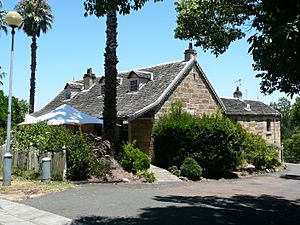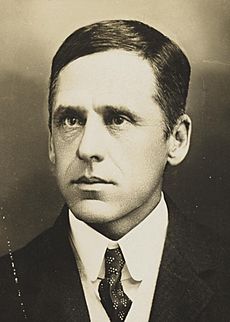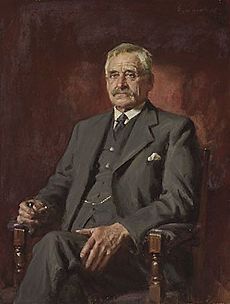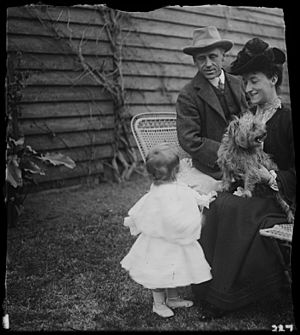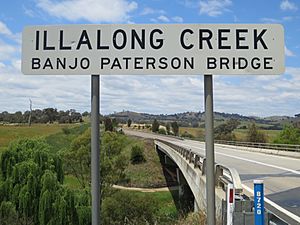Banjo Paterson facts for kids
Quick facts for kids
Banjo Paterson
|
|
|---|---|
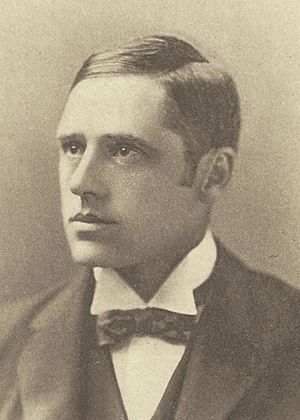
Banjo Paterson, circa 1890
|
|
| Born |
Andrew Barton Paterson
17 February 1864 "Narrambla", near Orange, New South Wales, Australia
|
| Died | 5 February 1941 (aged 76) Sydney, New South Wales, Australia
|
| Resting place | Northern Suburbs Crematorium, Sydney, New South Wales, Australia |
| Occupation | Author, journalist, composer, clerk, poet |
| Spouse(s) |
Alice Emily Walker
(m. 1903) |
| Children | 2 |
| Relatives | John Paterson (uncle) |
| Signature | |
Andrew Barton Paterson, known to everyone as Banjo Paterson, was a famous Australian poet, journalist, and author. He was born on February 17, 1864, and passed away on February 5, 1941.
Banjo Paterson wrote many well-known poems and songs about Australian life. He especially focused on the countryside and the outback. He spent a lot of his childhood near Binalong, New South Wales, which inspired his stories.
Some of his most famous works include "Clancy of the Overflow" (1889), "The Man from Snowy River" (1890), and "Waltzing Matilda" (1895). "Waltzing Matilda" is so popular that many people consider it Australia's unofficial national anthem.
Contents
Banjo Paterson's Early Life
Andrew Barton Paterson was born on a property called "Narrambla," near Orange, New South Wales. He was the oldest son of Andrew Bogle Paterson, who came from Scotland, and Rose Isabella Barton, who was Australian-born. Rose was related to Edmund Barton, who later became Australia's first Prime Minister.
When Banjo was five, his family lived on Buckinbah Station near Yeoval, New South Wales. After his father lost his wool in a flood, they had to sell the farm. His family then moved to his uncle John Paterson's farm in Illalong, near Yass, New South Wales. This farm was close to the main road between Melbourne and Sydney.
Young Banjo often saw bullock teams, Cobb and Co coaches, and drovers. He also watched horsemen from the Murrumbidgee River and Snowy Mountains areas compete in picnic races and polo matches. These experiences made him love horses and inspired many of his writings.
Paterson first learned from a governess at home. Later, when he could ride a pony, he went to a bush school in Binalong. In 1874, he was sent to Sydney Grammar School. He did well there as both a student and a sportsman. During this time, he lived in a cottage called Rockend in Gladesville, New South Wales. This cottage is now a protected historical site. He left school at 16 after not getting a scholarship to the University of Sydney.
Becoming a Writer and Journalist
Paterson started his career as a law clerk in Sydney. He became a solicitor (a type of lawyer) in 1886. While working as a solicitor, he also began to write. From 1885, he sent his poems to The Bulletin, a popular literary magazine. They started publishing his work.
His first published poem was about the British war in Sudan, where Australians also fought. Over the next ten years, The Bulletin became an important place for his writing. He used the pen name "The Banjo," which was the name of his favorite horse. He became one of the magazine's most popular writers in the 1890s. He also made friends with other famous Australian writers like Henry Lawson. Paterson and Lawson even had a friendly poetry competition about life in the Australian bush.
War Correspondent
In October 1899, Banjo Paterson became a war correspondent for The Sydney Morning Herald and The Age newspapers. He sailed to South Africa to report on the Second Boer War. There, he met famous people like Winston Churchill and Rudyard Kipling. He also met important British army leaders.
His exciting reports about the Siege of Kimberley, the surrender of Bloemfontein, and the capture of Pretoria gained attention in Britain. He was the first correspondent to ride into Bloemfontein after its surrender. In 2020, a special box of chocolates made by Cadbury for Queen Victoria in 1900 was found among Paterson's old papers. It was meant as a New Year's gift for soldiers in South Africa.
Paterson also worked as a correspondent during the Boxer Rebellion in China. He met George Ernest Morrison there and later wrote about their meeting. He was also an editor for the Sydney Evening News (1904–06) and the Town and Country Journal (1907–08).
Military Service in World War I
In 1908, after a trip to the United Kingdom, Paterson decided to stop journalism and writing for a while. He moved with his family to a 40,000-acre property near Yass, New South Wales.
When World War I began, Paterson tried to become a war correspondent in France but was not chosen. Instead, he became an ambulance driver with the Australian Voluntary Hospital in France. He returned to Australia in early 1915. As an honorary vet, he traveled on three trips with horses to Africa, China, and Egypt.
He joined the 2nd Remount Unit of the First Australian Imperial Force on October 18, 1915. He served in France, where he was wounded and reported missing in July 1916. Later, he became the commanding officer of the unit based in Cairo, Egypt. He returned to Australia and left the army in April 1919, having reached the rank of major. His wife also helped during the war, working with the Red Cross in an ambulance unit near her husband.
Later Life and Legacy
When Paterson returned to Australia, his third poetry collection, Saltbush Bill JP, was published. He continued to write poems, short stories, and essays. He also wrote about rugby league football for the Sydney Sportsman newspaper in the 1920s.
Personal Life
On April 8, 1903, Banjo Paterson married Alice Emily Walker. They were married in St Stephen's Presbyterian Church in Tenterfield, New South Wales. Their first home was in Queen Street, Woollahra. They had two children, a daughter named Grace (born in 1904) and a son named Hugh (born in 1906).
Banjo Paterson passed away from a heart attack in Sydney on February 5, 1941, at the age of 76. He is buried with his wife at the Northern Suburbs Memorial Gardens and Crematorium in Sydney.
Famous Works

The publication of "The Man from Snowy River" and five other poems in The Bulletin made "The Banjo" a household name. In 1895, a publisher named Angus & Robertson released these poems as a collection. The book sold 5,000 copies in just four months!
In 1895, Paterson traveled north to Dagworth station near Winton, Queensland. He met Christina Macpherson there, who had heard a catchy tune at a race in Victoria. She played it for Paterson on her autoharp. The melody inspired him to write the words for "Waltzing Matilda". This song became one of his most famous and widely sung ballads.
He also wrote lyrics for songs with piano music, such as "The Daylight is Dying" and Last Week. These were published between 1895 and 1899. In 1905, he released Old Bush Songs, a collection of bush ballads he had been gathering since 1895.
Even though Paterson lived and worked in Sydney for most of his adult life, his poems often showed a very romantic picture of the Australian bush and the brave bushman. He was influenced by another Australian poet, John Farrell. Paterson's idea of the bushman as tough, independent, and heroic became a key part of the Australian national character. His work is often compared to the stories of Henry Lawson, especially Lawson's "The Drover's Wife," which showed a much harder side of life in the countryside.
Paterson also wrote two novels: An Outback Marriage (1906) and The Shearer's Colt (1936). He wrote many short stories, collected in Three Elephant Power and Other Stories (1917). He also wrote a book about his experiences as a war reporter, Happy Dispatches (1934), and a children's book called The Animals Noah Forgot (1933).
Today, you can find recordings of many of Paterson's poems read by actor Jack Thompson. Thompson played Clancy in the 1982 film The Man from Snowy River. There was also an Australian TV series with the same name in the 1990s, though it wasn't directly connected to the movie.
In 2008, a previously unknown poem by Paterson was found in a war diary from the Boer War.
Banjo Paterson's Legacy
Banjo Paterson's picture is on the Australian $10 note. The note also features an illustration inspired by "The Man From Snowy River" and the words of the poem written in tiny print.
In 1981, Australia Post honored him with a special postage stamp.
A school called A. B. Paterson College in Arundel on the Gold Coast is named after him. The A. B. "Banjo" Paterson Library at Sydney Grammar School is also named in his honor.
The Festival of Arts in Orange, New South Wales, gives out a Banjo Paterson Award every two years for poetry and plays. There is also an annual National Book Council Banjo Award. Orange also hosts an annual Banjo Paterson Poetry Festival.
A 47-year-old wooden boat from Victoria was named Banjo Paterson. It regularly travels up and down the Patterson River, which is a fun coincidence!
In 1983, a version of "Waltzing Matilda" sung by Slim Dusty was the first song ever broadcast from space by astronauts to Earth.
In 2013, Banjo Paterson topped the list of "The Greatest of All - Our 50 Top Australians" published in The Australian newspaper.
Images for kids
See also
 In Spanish: Andrew Barton Paterson para niños
In Spanish: Andrew Barton Paterson para niños


